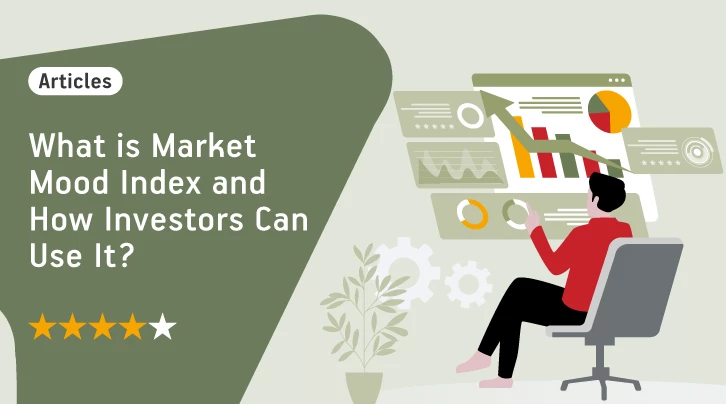Knowing the collective mood or sentiment of the market participants can help you plan your investments better. The Market Mood Index (MMI) metric is precisely created for this objective. Read this post to learn more.
The collective greed and fear of all the participants significantly influence market behaviour. So, wouldn’t it be easier to plan your trades and invest if you were able to know what others are currently feeling about the market? The MMI or Market Mood Index is a metric created to decipher the market’s emotional pulse.
Here’s a detailed explanation of what it is, how it works, and more-
What is Market Mood Index (MMI)?
The Market Mood Index or MMI is a market sentiment metric developed by MarketPsych, a US-based quantitative behavioural finance research company, in 2004. What started as a survey-based sentiment metric has now evolved into a highly sophisticated index leveraging advanced technologies such as sentiment analysis, machine learning, and natural language processing.
Here are the data points used by the current version of the MMI index-
● Participant emotions
● Prediction and price action
● Management and fundamentals
● Economic and geopolitical movements
● Environmental, sustainability, and governance
Currently, the MMI index is available for 200+ countries, 100k+ individual companies, 50+ commodities, 40+ currencies, and 500+ digital currencies.
How to Interpret Market Mood Index?
The MMI is generally represented in a numerical value ranging from 0 to 100, with 50 being neutral. Scores below 50 indicate pessimism and negative or bearish market sentiment. If the score climbs above 50, it demonstrates optimism and bullish sentiment. Stock traders and investors can use this metric for informed decision-making. Not just that, but mutual fund investors can also use this to understand the overall market sentiment and decide accordingly.
Also read :
For instance, if an investor wants to purchase NIFTY Futures or an individual stock for short-term or intraday, the MMI score in the range of 60-80 can help him make the decision more confidently, as other market participants are also optimistic about the Indian market.
What are the Benefits of Using the Market Mood Index?
Quick Overview of Market Sentiment
Understanding the pulse of the market is good for trading or investing successfully. While there are times when you can trade or invest against the collective market sentiment and generate profits, such occurrences are not frequent. The MMI index offers an instant snapshot of the market sentiment to help you with your investments.
Informed Decision-Making
Traders and investors often rely on technical and fundamental analysis to make buying and selling decisions. While this is a good practice, it may not give you the desired results. Remember, returns are never guaranteed, and there are a lot of factors at play. Sometimes, even technically sound trades and fundamentally solid investments can fail if the market sentiment is not in favour. So, the MMI functions as a vital data point to help market participants make informed decisions.
Understand the Impact of External Events
External events like government policies, environmental issues, civil unrest, election results, etc., impact market behaviour. The changing MMI score can help participants better understand the impact of these events on the market. For example, investors may choose to open fresh positions if the sentiment is turning bullish or exit current positions if the MMI indicates bearishness.
What are the Alternatives to Market Mood Index?
The official MMI by Market Psych tracks the Indian stock market. However, there are some other India-focused metrics that investors can consider. Take a look-
India VIX Index
The NSE introduced the India VIX Index in 2004 to measure the market’s expectation of near-term volatility and fluctuations based on index option prices. It is generally believed that a higher VIX means higher expected volatility and higher investment risk.
Fear and Greed Index (FGI)
The Fear and Greed Index or FGI is divided into four parts- Extreme Fear (<30), Fear (30-50), Greed (50-70), and Extreme Greed (>70). Extreme fear is generally considered a good opportunity to initiate fresh buy trades as the market is oversold. However, traders and investors should be cautious when the FGI is in the Extreme Greed zone, which represents an overbought market.
Invest Smarter with the Market Mood Index
Successful investors and traders are known for controlling their fear and greed, two key emotions driving market sentiments. With the MMI index, you can get an instant overview of the market sentiment and make informed decisions. Use it along with other analysis tools to boost your profitability.
If you’re new to the stock market, ensure you spend enough time mastering the basics and understanding the forces that drive market behaviour. New equity investors can also begin their investment journey through mutual funds by selecting schemes that suit their risk appetite and investment objectives.
Also read: Types of Mutual Funds
Mutual Fund investments are subject to market risks, read all scheme related documents carefully.





 1800-270-7000
1800-270-7000




